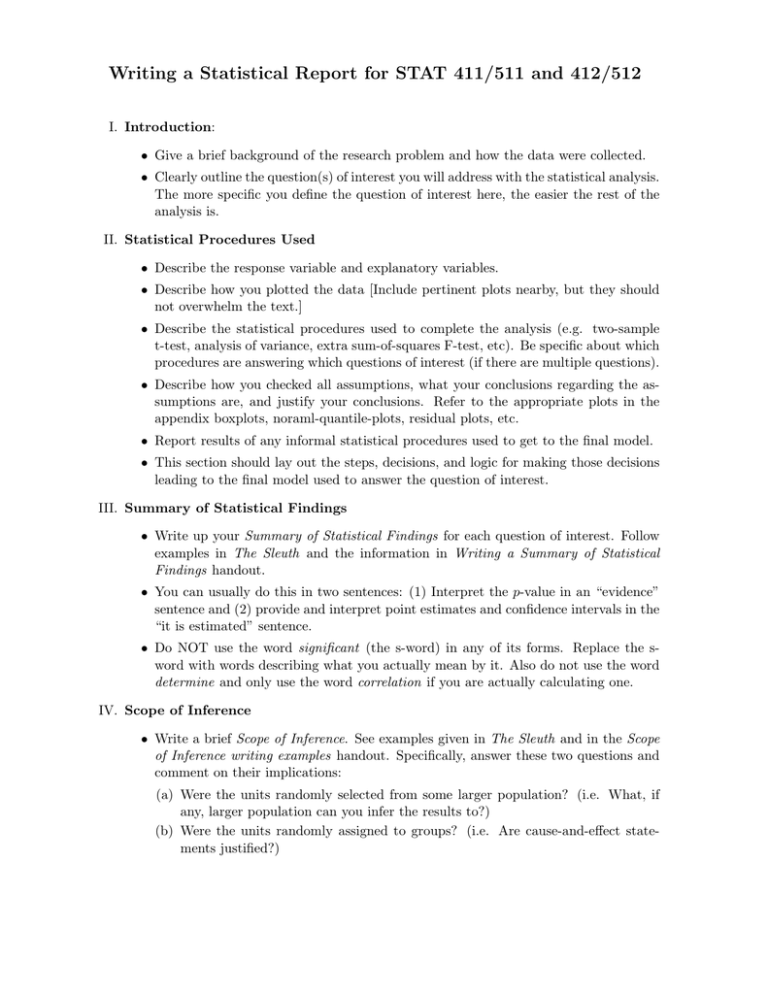Statistical Report Writing Guidelines for STAT Courses
advertisement

Writing a Statistical Report for STAT 411/511 and 412/512 I. Introduction: • Give a brief background of the research problem and how the data were collected. • Clearly outline the question(s) of interest you will address with the statistical analysis. The more specific you define the question of interest here, the easier the rest of the analysis is. II. Statistical Procedures Used • Describe the response variable and explanatory variables. • Describe how you plotted the data [Include pertinent plots nearby, but they should not overwhelm the text.] • Describe the statistical procedures used to complete the analysis (e.g. two-sample t-test, analysis of variance, extra sum-of-squares F-test, etc). Be specific about which procedures are answering which questions of interest (if there are multiple questions). • Describe how you checked all assumptions, what your conclusions regarding the assumptions are, and justify your conclusions. Refer to the appropriate plots in the appendix boxplots, noraml-quantile-plots, residual plots, etc. • Report results of any informal statistical procedures used to get to the final model. • This section should lay out the steps, decisions, and logic for making those decisions leading to the final model used to answer the question of interest. III. Summary of Statistical Findings • Write up your Summary of Statistical Findings for each question of interest. Follow examples in The Sleuth and the information in Writing a Summary of Statistical Findings handout. • You can usually do this in two sentences: (1) Interpret the p-value in an “evidence” sentence and (2) provide and interpret point estimates and confidence intervals in the “it is estimated” sentence. • Do NOT use the word significant (the s-word) in any of its forms. Replace the sword with words describing what you actually mean by it. Also do not use the word determine and only use the word correlation if you are actually calculating one. IV. Scope of Inference • Write a brief Scope of Inference. See examples given in The Sleuth and in the Scope of Inference writing examples handout. Specifically, answer these two questions and comment on their implications: (a) Were the units randomly selected from some larger population? (i.e. What, if any, larger population can you infer the results to?) (b) Were the units randomly assigned to groups? (i.e. Are cause-and-effect statements justified?) • Make sure you write the Scope of Inference specific to the language of the problem (not just generic statements). For example, DO NOT say “There was no randomization so cause and effect statements cannot be made.” Instead, for example, say “The lizards were not randomly assigned to diets, therefore we can not conclude that the fly diet caused any increase in average weight over the lizards on the tofu diet.” • OTHER: – Style: Report must be written in complete sentences in paragraph format. Use the above four headings in your report so that it is clearly organized. – Length: The body of the report should be no more than 2 pages double spaced! – Appendix: You can include any plots, hand calculations, and R-code (as little as is necessary) in an appendix and NOT in the body of the report! – Part of the grade for each homework is based on writing (organization, grammar, appropriate use of statistical terms, etc.) – I expect you to use the comments I provide on your homework’s to improve subsequent reports and assignments!



